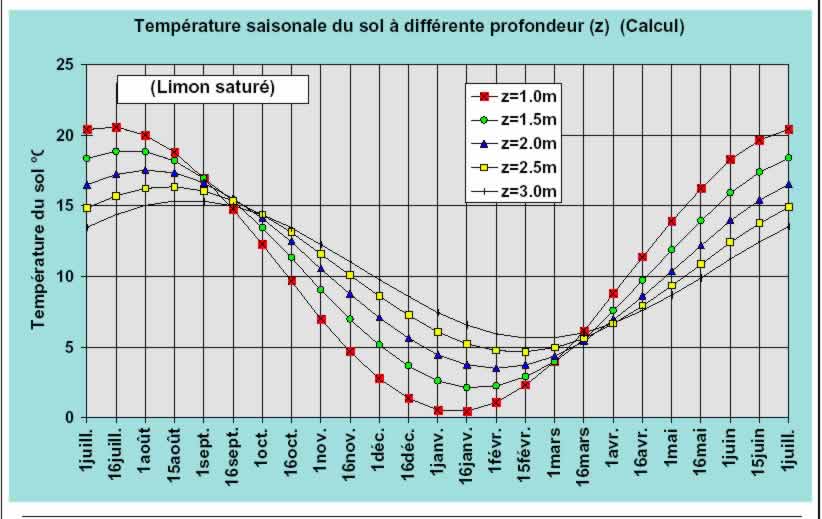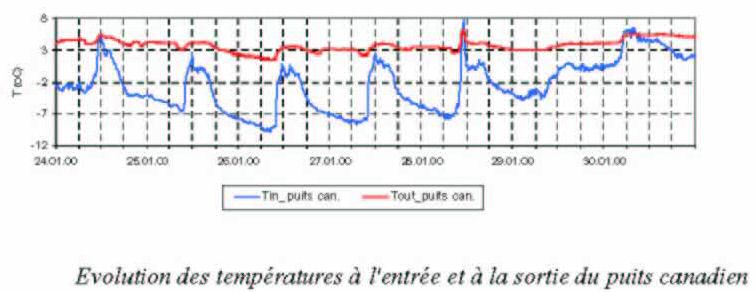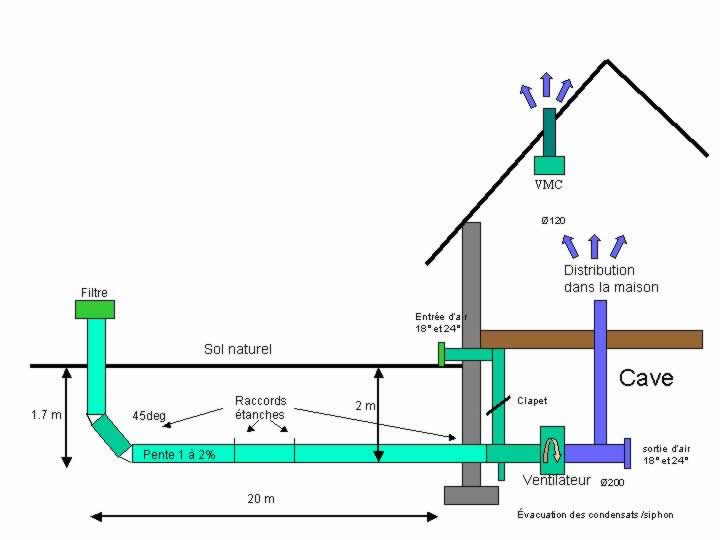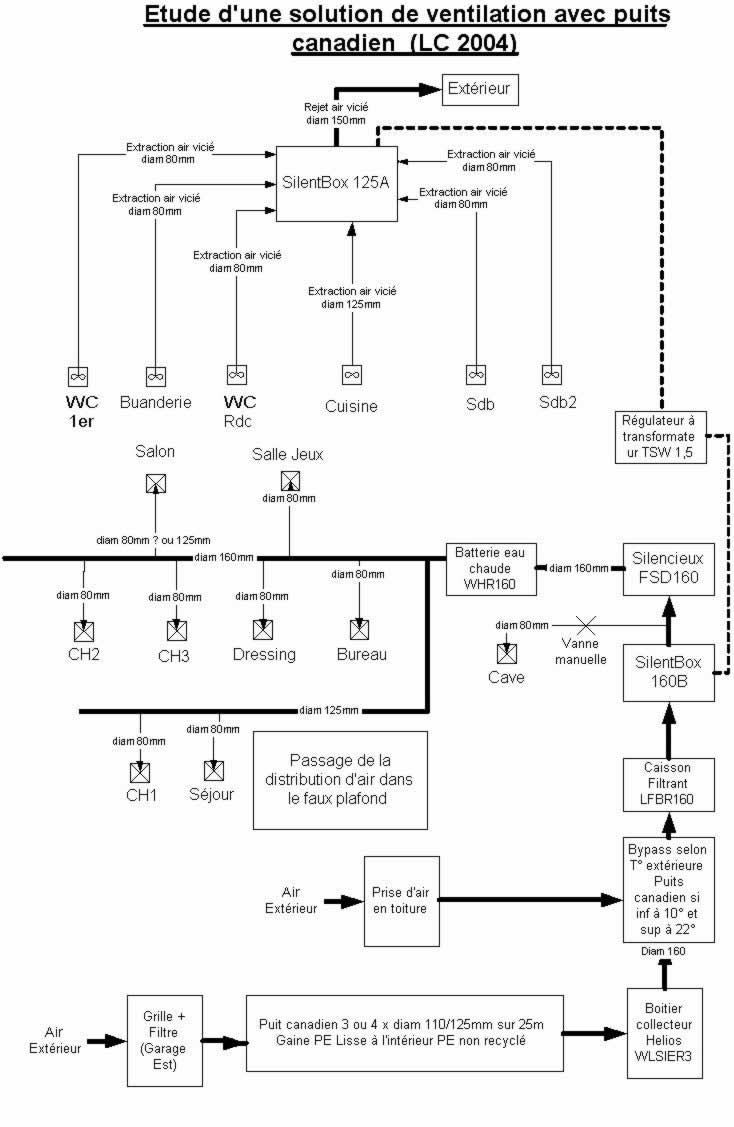The Canadian well (or Provençal well)
More:
- Forum Eco-Construction
Keywords: build, size, house, bioconstruction, ecohabitat, bioclimatic, energy
An unrecognized system that can reduce the temperature of 5 to 8 ° C in your home on hot days for a derisory power consumption.
It also reduces heating consumption in winter ...
Humans and temperature
The human being feels good between 18 and 25 °. It spends a lot of energy to keep the temperature within this range, but it does not always succeed. In winter we heat, in summer we air conditioning.
The Canadian well is a system that uses the thermal inertia of the ground to equalize these thermal variations.
fundamentals
The legislation requires a VMC (motorized ventilation) to prevent humidity in your home.
The soil temperature at a depth of 2 m is around 17 ° in summer and 4 ° in winter
Warm air stores more moisture than the same volume of cold air and vice versa.
The Canadian well is a system that uses the thermal inertia of the ground.

Click to enlarge
Principle of the Canadian well
By burying an air intake duct of sufficient length and diameter at this depth, whatever the outside temperature, at the end of the duct it will be around 12 ° in summer and around 6 ° in winter.
In winter the cold outside air, warming itself therefore becomes relatively drier. It arrives in the house at 6 ° and you only spend energy to heat it to 20 °.
In summer, when it is hot and humid outside, the warm air saturated with humidity will condense in the duct to then cool the house.
Disadvantages of VMC
The VMC is used to reject hot air (and all the energy contained therein) outside. We can assume that it suits EDF and the oil branch.
Any discharge of stale air to the outside implies the replacement of this air by air coming from the outside. To this end, artificial openings (the intake vents in window frames) are provided which allow the intake of fresh air. All these openings are so many
thermal bridges.
In summer, the house is thus heated artificially. In winter, the area is unnecessarily heated, since the air coming from outside must be heated from -5 ° to 20 °. The Canadian well saves energy in winter and cools the house in summer.

Click to enlarge
How the Canadian well works
There are problems, and limits of use, of course.
In principle, the volume of air passing through the ground must not be pulsed too fast (max 3m / s) or too high. In this case, it will not heat up enough.
For this reason, the ratio between the volume of air and the exchange surface of the tube (which contains it) with the soil must not be greater than 6.
That is, after calculation and simplifications, a general formula giving radius <12 cm. The maximum diameter of a Canadian well tube must therefore be 24 cm.
Application:
Let's take a tube of 20 cm in diameter on 20 m long. A speed of 3 m / s theoretically gives 340 m3 / h approximately. The reality is closer to 220 m3 / h (pressure drops).
However, according to EDF and the heating engineers, it is necessary to provide for a total renewal of the air volume of a house, per hour. So at full capacity, our Canadian well could not supply a home of more than 340m3 ie 126m2.

Click to enlarge
A total renewal every hour seems quite exaggerated to us, except for small overheated and "over-inhabited" houses.
In fact a well-designed home, and at normal 30m2 volume per capita can only renew its air as every 8 hours.

Click to enlarge
The use of a Canadian well 20 m long, 20 cm in diameter at a speed of 2m / s, operating continuously throughout the year with a lower speed, so a heat exchange with the upper ground, will allow condition a well insulated 120 m2 (324 m3) house with an air renewal about every 3 hours (this seems realistic and reasonable.).
The Canadian well also makes it possible to maintain frost-free, unoccupied second homes in winter.

Click to enlarge
Practical advice
1) If the volume of air supplied by the well is insufficient, house too big or too wide-footed, it is better to dig a second well, elsewhere, than to double the existing one.
2) It takes electricity: for the fan / circulator. (20 to 35 w per hour of operation).
3) Always provide 1.5 meters of soil at least on both sides of the Canadian well.
4) The pipe should be smooth inside, roughness would create turbulence and the exchange would not be optimal. Opt for a smooth PVC pipe. Concrete is a bad conductor due to the thickness of the walls, the coating of sand and the waterproofing will be difficult to achieve (Attention Radon). Depending on the nature of the soil, the length of the pipe must be increased (see curves)
5) The pipe should not exceed 20 cm in diameter (see curves); a larger section will create a flow in the center of the pipe that will not touch the walls, so still a bad exchange.
6) The input can be protected by a filter. In any case, be sure to put a grill to prevent rodents from entering.
7) Make sure to have a slope of 2 to 3% for the evacuation of the condensation water and thus protect your fan. Condensate draining will be done with a siphon placed inside the house. If you wish to avoid the installation of a drain for the siphon, you can leave a part in ground under this one and the evacuation of the water will be by infiltration into the ground.
8) Calculate the power of your fan according to the pressure drop and the actual volume of your home. The specialists in air or air conditioning are equipped with software.
Closing the air inlets above the windows
9) A VMC (Controlled Mechanical Ventilation) will ensure the renewal of air in your home. CMV flow must be slightly lower than Canadian well flow
10) When the outside temperature is between 10 and 24 °, you may not want to cool your house. In this case, you can either send the air from the Canadian well into the cellar by removing the plug on the fan outlet or the ideal would be to have an additional inlet and draw air directly without going through the well. Your home will be ventilated all year long. By installing a motorized flap and a temperature sensor, you will have a fully automated solution. Because in any case you must cut the fan over too long, fungi and parasites may develop in the pipe.

Click to enlarge
Concrete example of a Canadian well
The house has a living area of 280m2 and therefore a large volume about 700m3. The material is sized according to these parameters.
Dimensioning:
1) 45 m PE pipe diam 200 (outside) buried at 1,80 m
2) VMC dual stream KWL350
3) Reducer 200/160 for the distribution of air in the house. It is important to stay in a large diameter> 125 to avoid pressure drops but especially because of the noise generated in the case of a diameter of 80.
4) Manual or motorized damper and 200 / 160 gearbox for direct air drawing
5) 125 pipe diameters for the distribution of air in the house (living room, dining room, bedrooms) coming from the Canadian well or from the direct outlet depending on the outside temperature.
Examples by diagrams:

Air flow diagram: click to enlarge
Warning: Radon and Canadian Well.
Radon is a naturally occurring radioactive gas.
It comes from the decay of uranium and radium present in the earth's crust. It is present everywhere on the surface of the planet and comes mainly from granite and volcanic subsoils as well as from certain construction materials.
Radon is one of the lung cancer agents, however far behind tobacco.
Radon can accumulate in confined spaces, especially in homes.
The means to reduce radon concentrations in homes are simple:
- ventilate and ventilate houses, basements and crawl spaces;
- improve the waterproofing of walls and floors.
In the 31 departments most concerned, the local authorities must have this radioactive gas tested in certain places open to the public for extended stays (in particular, educational establishments and health and social establishments).
Allier, Ariège, Hautes-Alpes, Ardèche, Aveyron, Calvados, Cantal, Corrèze, Corse du Sud, Haute-Corse, Côtes-d'Armor, Creuse, Doubs, Finistère, Indre, Loire, Haute-Loire, Lozère, Haute- Marne, Morbihan, Nièvre, Puy-de-Dôme, Hautes-Pyrénées, Rhône, Saône-et-Loire, Savoie, Haute-Saône, Deux-Sèvres, Haute-Vienne, Vosges, Territoire de Belfort
In a private home, the radon test can be done at the initiative of the occupant. He can do it himself, by purchasing a dosimeter from one of the companies that markets them, or by calling on a professional.
Radon can be blown into the house using the Canadian well if the pipe bringing air from outside is not waterproof
To know more:
- A thesis from the University of Geneva on the Canadian well entitled: “Use of air / floor exchangers for heating and cooling buildings. In situ measurements, analytical modeling, numerical simulation and systemic analysis ”
- Forum eco-construction talking about the Canadian well

